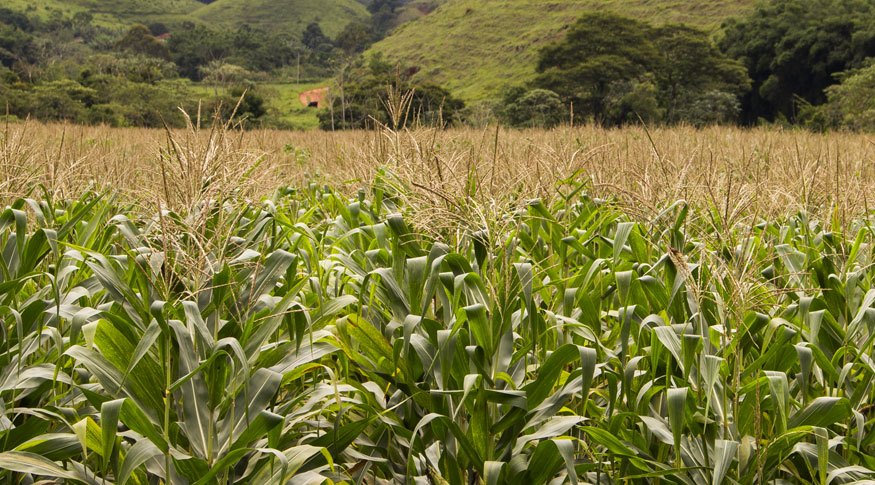Agricultural production
July´s estimate forecasts record harvest of 256.1 million tonnes in 2021
August 10, 2021 09h00 AM | Last Updated: August 10, 2021 04h44 PM

The estimate for the Brazilian harvest of cereals, legumes and oilseeds in 2021 was reduced for the fourth consecutive month, though it remains a record and should reach 256.1 million tonnes until the end of the year. The late planting of corn - 2nd crop and the lack of rainfall during the culture cycle affected the productivity of the crops of corn, which is one of the major commodities of the Brazilian agriculture. On the other hand, the output of soybeans remains rising its records. Together with rice, these two products represent 92.4% of the harvest.
The data come from the Systematic Survey of Agricultural Production - LSPA, released today (10) by the IBGE. The estimate for 2021 reached 264.9 million tonnes in the March report, though it has been reducing since April. However, it still remains 0.8% above that obtained in 2020, which had already been a record, of 254.1 million tonnes.
“Corn is planted after soybean and, as it delayed, the planting window for corn became smaller. Having already been planted out of the ideal time and having rained less than expected in the cropping period, the corn harvest was quite affected by the climate. The average yield of this cereal declined 16.7%,” explains Carlos Barradas, manager of the survey.
The production estimate for corn declined 3.6%, adding up to 91.6 million tonnes. The drop is of 11.3% over 2020, though the planted area has increased 6.6%. The forecast of the first crop even increased 2.4% over the previous month, but the second crop, which is the major one, declined 5.9%. In relation to the previous year, the estimate for the second harvest was 15.0% lower, despite the increase of 8.2% in the planted area.
On the other hand, the 2021 harvest of soybean has already finished and the commodity reached its best result in the time series of the LSPA, adding up to 133.4 million tonnes, 9.8% above the output in 2020, the equivalent to 11.9 million tonnes.
“The crop developed satisfactorily in most producing units. Rio Grande do Sul recovered its production, which was very affected by the drought in 2020, resulting in a growth of 80.6% and hitting a record of 20.43 million tonnes, with an average productivity of 3,341 kilos per hectare,” stresses the researcher.
With this production, this state became the second biggest national producer of soybeans, surpassing Paraná, where the crops were affected by the drought, which reduced its output by 4.7% over 2020. Nevertheless, other states registered a drop in the average yield of the crops due to climate problems, as is the case of Mato Grosso (-3.5%), Paraná (-6.7%) and Goiás (-2.4%). In the region comprising the states of Maranhão, Tocantins, Piauí and Bahia, known as MATOPIBA, only Tocantins reduced the output (-6.3%). And Bahia recorded the highest average productivity in Brazil for this grain: 4,020 kg/ha.
The estimated production of rice was of 11.5 million tonnes, an increase of 2.6% over the previous month and of 4.1% over the 2020 harvest.
“That production will be sufficient to supply the Brazilian domestic market, allowing more balanced prices of the cereal, which hit a historical level in 2020, as a result of the increase in the domestic consumption and in the exports, due to the currency stimulus,” highlights Carlos Barradas.
However, the estimate for beans reduced 1.6%, though it should still remain 0.5% above the 2020 harvest. According to Barradas, if the production remains within expected, though tightly, it should be sufficient to address the consumption of the Brazilians, not requiring imports nor rising prices.
Production in Central-West should fall 4.6% over the previous year
The South (7.5%), Northeast (4.9%), Southeast (3.4%) and North (0.9%) regions registered a rise in their estimates. The first one should produce 78.6 million tonnes (30.7% of the national overall); the second one, 23.7 million tonnes (9.3% of the total); the third one, 26.6 million tonnes (10.4% of the total) and the fourth one, 11.1 million tonnes (4.3% of the total).
For the Central-West, which is the biggest producer (45.3% of the national overall), a drop of 4.6% was estimated over 2020 and it should produce 116.1 million tonnes in 2021.
Among the Federation Units, Mato Grosso leads the national production of grains with a share of 27.7%, followed by Paraná (14.6%), Rio Grande do Sul (13.7%), Goiás (9.1%), Mato Grosso do Sul (8.3%) and Minas Gerais (6.4%). These states together accounted for 79.8% of the national forecast.
About the LSPA
Launched in November 1972 aiming at addressing the demand of users for monthly short-term statistical information, the LSPA provides estimates of planted area, harvested area, amount produced and average yield of products selected based on criteria of economic and social importance for Brazil. It not only follows up each crop investigated in the calendar year of reference, from the intention to plant up to the end of the harvest, yet also the forecast of the harvest in the coming year, for which the months of October, November and December are surveyed. Please access the data on Sidra.




















